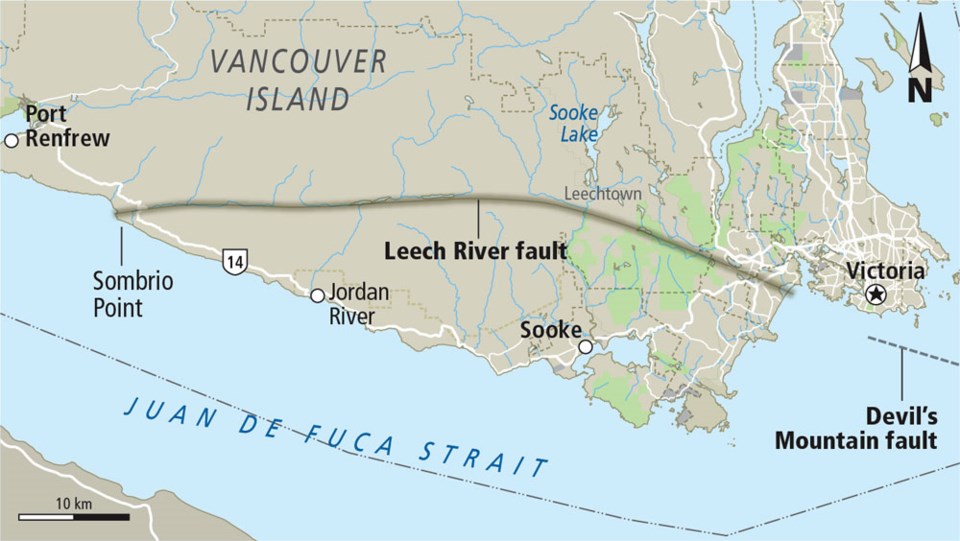A fault line running a few kilometres from downtown Victoria could be active, new research has found.
The Leech River crustal fault, which runs from Sombrio Beach through Royal Roads University and offshore of downtown Victoria, was long believed to have been inactive for millions of years.
But it has caused at least two major earthquakes in the past 12,000 years, lead researcher Kristin Morell said.
“The Leech River fault was obviously active 50 million years ago, that has long been known,” said Morell, who is a University of Victoria geologist.
“But what we didn’t know was that it has ruptured at least two times in the past approximately 12,000 years. That’s new information that had not been proven.”
The two quakes are estimated to have a magnitude of 6.5 to 7.
Crustal faults are difficult to study because they can show no detectable seismic activity for thousands of years.
Morell and her team wanted to study the fault because it appears to connect with the Devil’s Mountain fault, which was also recently mapped through the Strait of Georgia and found capable of causing a magnitude-7.5 earthquake off Victoria.
Morrell’s team used data collected with a LiDAR (Light Detection and Ranging) system, which maps the Earth’s terrestrial surface by sending laser pulses from an aircraft. They found very subtle evidence of a bank or slope.
“What we think happens is that with these shallow earthquakes that rupture to the surface, they essentially create a ‘step’ within a matter of seconds. So those old steps — what we’re looking for in the landscape — are clues,” she said.
The discovery suggests the fault is still active.
“We don’t know for certain, but it makes it more likely that it has the potential to rupture in the future,” Morell said.
The study was published in the March-April issue of GSA Today, although some of the information has been printed previously. For example, it was incorporated in a study commissioned by the City of Victoria looking at how three earthquake scenarios would affect city infrastructure.
The city-wide vulnerability study assessed the impacts of three earthquake scenarios, including a magnitude-7 rupture of the shallow Leech River fault, a deep magnitude-7 earthquake in the Strait of Georgia, and a magnitude-9 full rupture of the Cascadia subduction fault.
It found the Leech River rupture had a much lower probability of occurrence than the others.
The city’s study, conducted by VC Structural Dynamics, found that a Leech River fault rupture would be extremely damaging, with the potential to completely destroy sewer lines and render up to 80 per cent of the city’s water pipelines unserviceable.
In the worst-case scenario, public access to downtown would be restricted, halting business and leaving many people homeless.
An estimated 64 per cent of buildings would be extensively damaged and three per cent would be destroyed — similar to the damage predicted for a Cascadia subduction zone quake, which is predicted to cause the “Big One.”
The Leech River fault is too small to produce a magnitude-9 quake, Morell said, but its proximity to the surface could mean strong shaking.
“It’s a different type of hazard. What exactly that means requires further study,” she said.
The next step in the team’s research will be narrowing down when the two recent earthquakes occurred, by trenching and studying deposits in various rock layers along the fault.
Morell said that if the Leech River fault is active, it’s highly likely that a network of other crustal faults on Vancouver Island is active, too.
“I don’t want the public to become alarmed about this,” she said.
“What it’s doing is informing us. The better informed we are, the better we can make decisions that actually keep us safe.”



